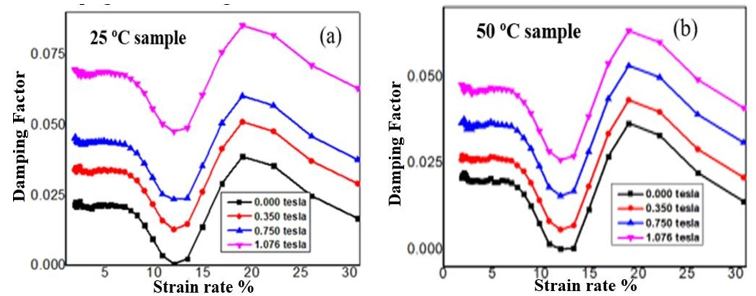Advance effect of magnetic field on the rheological properties of manganese zinc ferrite ferrofluid
Keywords:
Complex viscosity, Magnetization, Coercivity, ModulusAbstract
The rheological characteristics of manganese zinc (Mn-Zn) ferrite magnetic nanofluid synthesized using co-precipitation technique were examined in the absence and presence of magnetic fields. The research formulates required conditions needed for the formation of a gelly-like structure. The impact of magnetic field and temperature on the rheological properties of Mn-Zn ferrite ferrofluid is investigated. When a magnetic field was applied, higher magnetoviscoelasticity and magnetoviscosity were formed. Analysis was also done on other rheological parameters, such as the damping factor, which is crucial for regulating and restricting vibrations in a system. A stiff, gel-like structure is produced when a magnetic field is applied, and the gel-like quality grows as the magnetic field increases; when the magnetic field is removed, the gel-like and rigidity of the structure is lost. At low temperatures, the liquid phase is dominated by solid-like particles, whereas at high temperatures, the liquid-like structure is dominant. This study reveals the conditions required for the creation of high viscous effect and the viscoelastic behavior induced by the field offers important insights for optimizing the Mn-Zn ferrite ferrofluid for a range of applications. Other criterial for gel-like structure formation such as low torque and deflection angle of the ferrofluid were also established.

Published
How to Cite
Issue
Section
Copyright (c) 2024 A. A. Ibiyemi, O. Akinrinola, G. T. Yusuf, S. Olaniyan, J. Lawal, M. Orojo, B. Osuporu

This work is licensed under a Creative Commons Attribution 4.0 International License.
How to Cite
Most read articles by the same author(s)
- A. A. Ibiyemi, G. T. Yusuf, O. Akirinola, M. Orojo, B. Osuporu, J. Lawal, Investigating the magnetic domain structure and photonics characters of Singled Phased hard ferromagnetic Ferrite MFe3O4 (M= Co2+, Zn2+, Cd2+) Compounds , Journal of the Nigerian Society of Physical Sciences: Volume 6, Issue 1, February 2024







